CHAPTER V.
THE SHANNON AND ITS LAKES
NO river in Great
Britain, neither the Thames, nor the Clyde, nor even the Severn,
equals the river Shannon and its lakes, either in length or in
importance as an inland waterway. The native on its banks tells you
that it rivals the Mississippi; but in what respect, Americans, at
least, will wonder. Except that it broadens to perhaps a dozen miles
in the widest of its lakes, there is, of course, no comparison
whatever. The traffic on the river is of no great magnitude compared
with that on the Thames and the Clyde; but, were there a demand for
such, its capacity would be far greater than either.
Moreover, for beauty,
either of the dainty and popularly picturesque sort, or of the
supremely grand, it has preëminence, and one can journey its whole
length, from Killaloe, practically a suburb of Limerick, to
Carrick-on-Shannon, something over a hundred miles, in steamboats of
really comfortable, if not exactly luxurious, appointments.
It is the tourist traffic
mostly that is catered for; and the traveller, in the season, is
likely to find the company mixed, though by no means is it of the
“tripper” class.
The itinerary comprehends
much that is beautiful and much that is historic.
From Limerick, one
usually makes his way by train, although he may go by car or coach, —
such a trip is well worth while, — and embarks upon the tiny
steamer at Killaloe.
Here, at the lower end of
Lough Derg, near Killaloe, stood in the ninth century Brian Boru’s
palace of Kincora. The mound on which it was built is all that
remains of a place that displayed, twelve hundred years ago, the
greatest glory of the proud Irish kings.
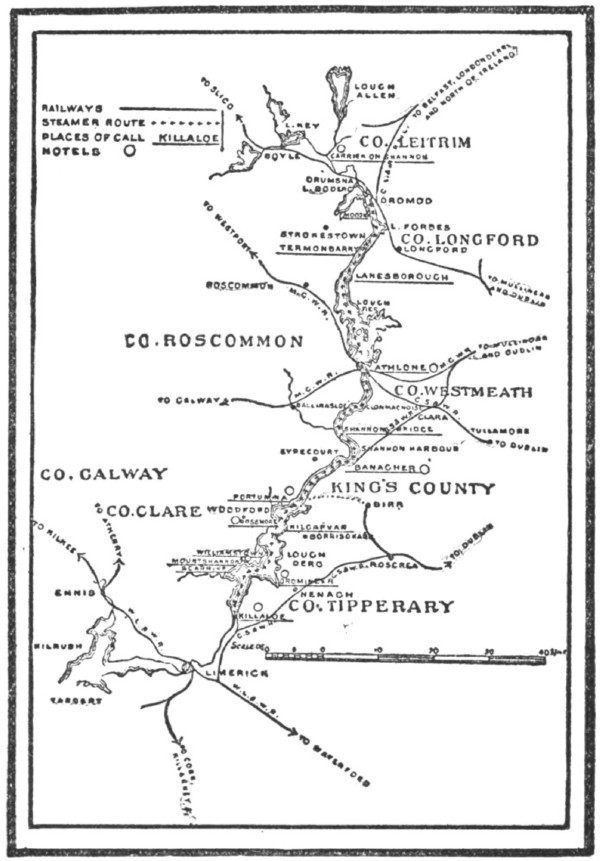
THE SHANNON AND ITS LAKES
Many were the events of
historical moment which took place here, though, as a palace of great
splendour and magnitude, it may have been exceeded by Tara and
Emania.
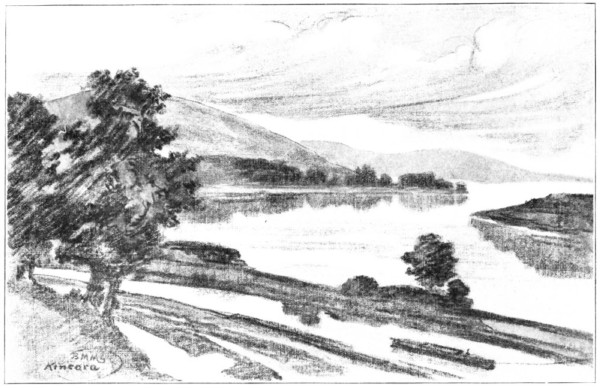
KINCORA.
The memory of Brian
Boru’s life here places him in the annals of the world’s great
rulers as “every inch a king.”
Neither on the Irish
throne, nor on that of any other kingdom, did there ever sit a
sovereign more splendidly qualified to rule; and Ireland had not for
some centuries known such a glorious and prosperous, peaceful, and
happy time as the five years preceding Brian’s death. He caused his
authority to be not only unquestioned, but obeyed and respected in
every corner of the land. So justly were the laws administered in his
name, and so loyally obeyed throughout the kingdom, that the bards
relate a rather fanciful story of a young and exquisitely beautiful
lady, who made, without the slightest apprehension of violence or
insult, and in perfect safety, a tour of the island on foot, alone
and unprotected, though bearing about her the most costly jewels and
ornaments of gold. This legend will be further recalled by the memory
of the well-known verses beginning “Rich and rare were the gems she
wore.”
It was at Kincora that
the following incident took place:
Mælmurra, Prince of
Leinster, playing or advising on a game of chess, made or recommended
a false move, upon which the patriotic Morrogh, son of Brian,
observed that it was no wonder Mælmurra’s friends, the Danes (to
whom he owed his elevation), were beaten at Glenmana, if he gave them
advice like that. Mælmurra, highly incensed by the allusion, — all
the more severe for its bitter truth, — arose, ordered his horse,
and rode away in haste. Brian, when he heard it, despatched a
messenger after the indignant guest, begging him to return; but
Mælmurra was not to be pacified, and refused, and concerted and
connived with certain Danish agents, always open to such
negotiations, those measures which led to the great invasion of the
year 1014, in which the whole Scandinavian race, from Anglesea and
Man, north to Norway, bore an active part.
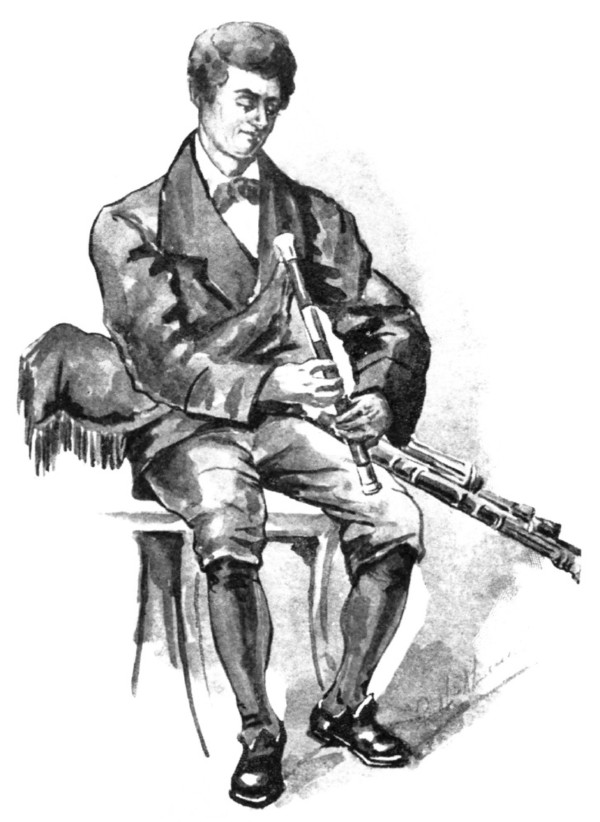
AN IRISH PIPER.
While Brian was residing
at Kincora, news was brought of his noble-hearted brother’s death,
whereupon he was seized with the most violent grief. Brian’s
favourite harp — always a legendary and traditional symbol of Irish
emotions — was taken down, and he sang that famous death-song of
Mahon recounting all the glorious actions of his life. “His anger
flashed out through his tears as he wildly chanted the noble lines,”
say the chronicles.
“My heart shall burst
within my breast,
Unless I avenge this
great king.
They shall forfeit life
for this foul deed,
Or I must perish by a
violent death.”
Of the passionate
attachment of the Irish for music, little need be said, as this is
one of the national characteristics which has been at all times most
strongly marked, and is still most widely appreciated, the harp being
universally held as a national emblem of Ireland. Even in the
pre-christian period that we are here reviewing, music was an
institution and a power in Erin.
Few spots in Ireland are
richer in historical and archæological interest than Killaloe. There
is a fine specimen of sixth-century architecture in the
well-preserved cell of St. Lua, with its steep roof of stone and
cunningly devised arches. It is a venerable building, and nestles
under the shadow of the present Protestant cathedral, built by
O’Brien, King of Thomond, in the twelfth century. On a small island
in the river Shannon are the ruins of an ancient friary, and at a
little distance the remains of a small chapel. These are said to mark
the position of a ford used by pilgrims who came to visit Killaloe
before the bridge, which is itself ancient, was built.
Lough Derg is reputedly
one of the prettiest pieces of water in Ireland. Its shores are well
wooded, and the background all around is made up of swelling upland,
dotted here and there with the white houses of the peasantry, while
in the far distance are the heather-clad hills of the Counties Clare,
Galway, and Tipperary.
In Lough Derg, on Station
Island, is the reputed entrance to St. Patrick’s Purgatory. A
wide-spread superstition accounts for its popularity, but whether as
a purely “tourist point” or as a place of pilgrimage for
penitents, it were better not to attempt to judge.
Tradition has it that St.
Patrick had prevailed on God to place the entrance to purgatory in
Ireland, that the unbelievers might the more readily be convinced of
the immortality of the soul and of the sufferings that awaited the
wicked after death. A few monks, according to Boate, an old Irish
writer, dwelt near the cavern that formed the entrance. “Whoever
came to the island with the intention of descending into the cavern
and examining its wonders had to prepare himself by long vigils,
fasts, and prayers, to strengthen him, as we are told, for his
dangerous expedition; but, in reality, by reducing his bodily
strength to make his imagination more ready to receive the
impressions which it was thought desirable to leave upon his mind. He
was then let down into the cavern, whence, after an interval of
several hours, he was drawn up again half-dead, and, when he
recovered his senses, mingling the wild dreams of his own imagination
with what the monks told him, he seldom failed to tell the most
marvellous tales of the place for the remainder of his life. It was
not till the reign of James II. that the monks were driven away from
the place, and the mystery of the dark cavern dissolved.”
From Killaloe to
Portumna, the Shannon flows through Lough Derg, a wide-spread
waterway, an elaborate expansion of the river itself. This lake,
which is twenty-five miles long and from two to six miles in breadth,
has an average depth of about fifty feet. Close to Portumna is the
Castle of Ballynasheera, said to have been once the residence of
Ireton, Oliver Cromwell’s son-in-law.
From Ben Hill, a few
miles below Portumna, near Woodford, is a splendid view of Lough Derg
and the surrounding country. The lake here stretches along between
the Slieve Aughty Mountains on the Connaught side and the Arra
Mountains on the Munster side, whose lofty summits tower up high into
the clouds. The shores, sloping gradually down to the water, are
covered with luxurious foliage, through openings in which may be seen
the ruins of many an ancient castle and once stately mansion.
Portumna itself is a
flourishing town, but of no great antiquarian interest. The
population of town and district is about two thousand.
Near by is Victoria Lock,
Melleek, adjacent to which are two strongly built towers, which
formerly mounted eight guns, and which, in more romantic times, were
erected to guard the pass of the Shannon between Connaught and
Leinster.
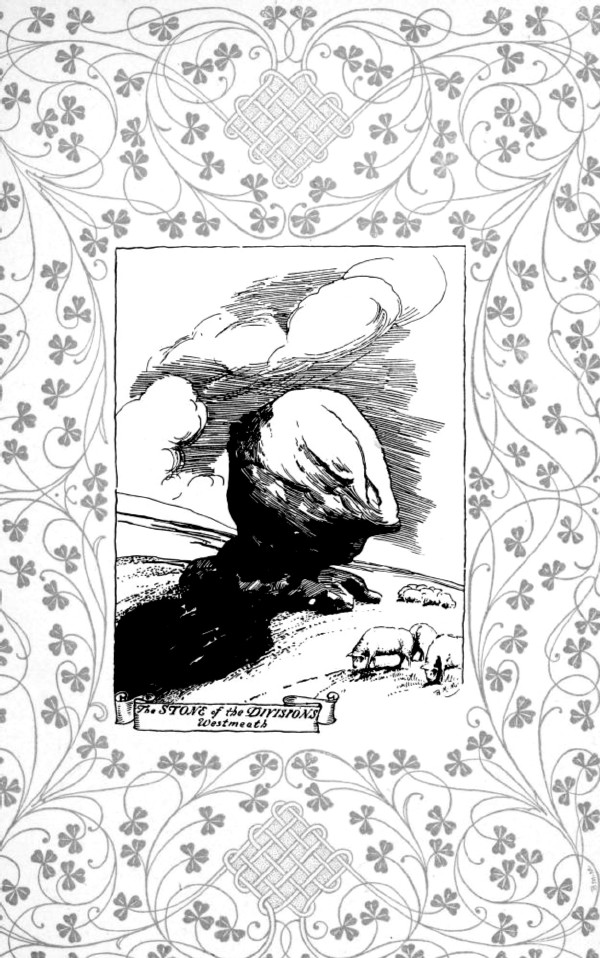
The Stone of the
Divisions, Westmeath
Shannon Harbour, at which
the Grand Canal joins the Shannon, is situated on the river about six
or seven miles from Shannon Bridge, and is immortalized by Charles
Lever in “Jack Hinton.”
As a tourist resort the
town appears to have degenerated sadly, a pretentious hotel
establishment having been converted over into barracks for the
constabulary.
From Shannon Harbour the
steamer passes Shannon Bridge, and in due course reaches Athlone at
the lower end of Lough Ree. “Population, seven thousand. Industry,
manufacture of the celebrated woollen tweeds, which provides
employment for several hundred operators, both male and female; there
are various other smaller manufacturing industries pursued by the
town population. In the rural districts, cattle rearing, both in
Westmeath and Roscommon, and the pursuit of general agriculture is
principally followed, and the inhabitants of these rural districts
are generally comfortable and fairly well-to-do.” Such is the usual
guide-book information concerning Athlone, which lies at the juncture
of Roscommon and Westmeath.
As a matter of fact,
however, almost every stone in the prosperous little city has a
historic interest and value, from the ruins of its former splendid
ecclesiastical establishments to its old houses and still more
ancient fortifications, and the castle erected in 1215 by King John,
— a counterpart in every respect of a similar establishment at
Limerick. Queen Elizabeth made Athlone the capital of Connaught.
After the battle of the Boyne, it underwent two sieges from the
forces of King William. Some traces of the old fortifications may be
seen, and the castle is still in perfect repair.
Just north of Athlone,
where the Shannon joins Lough Ree, is Auburn, more popularly known as
“Sweet Auburn,” whose old ruined parsonage is famous as the early
home of Oliver Goldsmith. 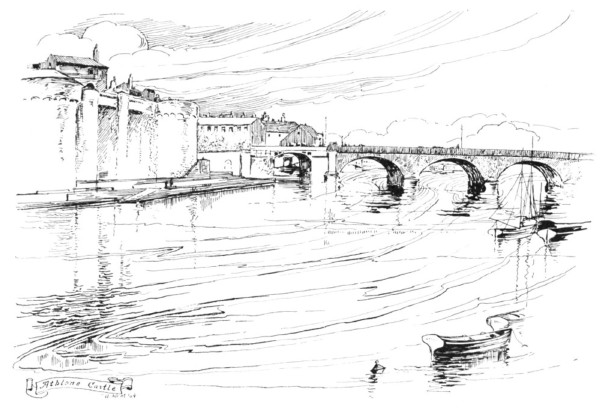
ATHLONE CASTLE.
Fleeting time has changed
this modest mansion — whose ruin was deplored by Goldsmith himself
— but little. It stands about a hundred yards from the public road
at the end of a straight avenue bordered with ash-trees, — a plain
rectangular, two-storied house, built in the ugly and uncompromising
style that was popular in Ireland in the early part of the
seventeenth century. The roof is off, but the walls remain, and seem
still to be haunted by the shade of the Rev. Charles Goldsmith, the
original Doctor Primrose in “The Vicar of Wakefield,” while his
wife, hospitable as of yore, still seems to invite the passing
stranger to taste her gooseberry wine. The famous inn, — since
rebuilt out of all resemblance to its former self, — immortalized
by Goldsmith, and known as the Three Pigeons, where were drawn the
“inspired nut-brown draughts,” and “where village statesmen
talked with looks profound,” is but a little distance from the
house. The country all around Lishoy — for that is the name of the
townland in which Toberclare, this Mecca of the Goldsmith student, is
situated — is well wooded and cultivated. The drive from Athlone to
“Sweet Auburn” is one of the most delightful in Ireland. As the
reputed locale
of “The Deserted Village,” Auburn, or Lishoy, as it was formerly
known, has an unusual share of interest for the literary pilgrim.
Goldsmith was not born
at Lishoy, as is sometimes stated, but in Pallas, a village in the
County Longford, his father being at the time a poor curate and
farmer. The infancy of Oliver was, however, spent in Lishoy, and
there is little doubt but that the scenes of his childhood became
afterward the imaginative sources whence he drew the picture of
“Sweet Auburn,” though it is doubtless true that the descriptions
are general enough in character to apply to many localities in
England as well as Ireland:
“Sweet Auburn!
loveliest village of the plain,
Where health and plenty
cheer’d the labouring swain;
Where smiling spring its
earliest visits paid,
And parting summer’s
lingering blooms delay’d.
Dear lovely bowers of
innocence and ease,
Seats of my youth, when
every sport could please;
How often have I
loitered o’er thy green,
Where humble happiness
endear’d each scene!
How often have I paused
on every charm!
The shelter’d cot, the
cultivated farm:
The never-failing brook,
the busy mill;
The decent church that
topp’d the neighbouring hill;
The hawthorn bush, with
seats beneath the shade,
For talking age, and
whispering lovers made.”
Attempts have been made
from time to time to justify the procedure, which is customary here,
of stripping the hawthorn of its blossoms to sell to tourists; and to
explain that it is a perfectly legitimate and artistic thing to have
hung the old broken plates and cups of the erstwhile Three Pigeons on
the walls of the new inn. Sir Walter Scott attempted to justify all
this as “a pleasing tribute to the poet,” but there is a hollow
mockery about it all that will make the true pilgrim hasten to
commune with “The never-failing
brook, the busy mill;”
and
“The decent church that
topp’d the neighbouring hill,”
all three of which exist
to-day, and bear a far greater likeness to the description of the
poet than does the reputed inn.
Through Lough Ree one
journeys along historical ground. Rindown Castle was built, it is
said, by Turgesius, a Dane, who made of it an impregnable stronghold,
as may be readily believed when one views its rocky promontory.
The island of
Inchcleraun, commonly called “Quaker Island,” is associated with
early Celtic Christianity, and has on it the remains of six churches.
On this island, Queen Meave is said to have been killed, while
bathing, by an Ulster chieftain, who threw a stone from a sling while
standing on the shore.
Knockcroghery Bay leads
to Roscommon, the chief town of the county of the same name. It had
its origin at the time when St. Coman founded a monastery there, and
to-day may still be seen elaborate remains of a former Dominican
establishment of the thirteenth century, and of a fortified castle of
the same era.
At the head of the
eastern arm is All Saints’ Island, on which are the well-preserved
remains of a church and monastery, — an ancient foundation which,
in the seventeenth century, was occupied by the nunnery of the Poor
Clares, but was burnt by the soldiery in 1642. It is recorded that
the peasants of Kilkenny West retaliated by killing the destroyers.
Inchbonin, the “Island
of the White Cow,” contains the remains of a church and monastery,
the foundation of the religious house being attributed to St. Rioch,
a nephew of St. Patrick. Here, also, are the remains of several
Celtic crosses.
Entering the Shannon
proper again at Lanesborough, one finally reaches Carrick-on-Shannon,
in itself uninteresting enough, but a centre from which a vast amount
of profitable knowledge may be obtained. It is the gateway of the
pretty valley of the river Boyle, where stands the pleasant little
town of the same name, with its famous abbey, which is in rather a
better state of preservation than many “chronicles in stone.” The
choir, nave, and transepts are all in existence, and show, in their
construction, all the elements of the West Norman and Gothic work of
their time. The nave, with its hundred and thirty-five semicircular
arches, which separate it from its aisles, is perhaps the best and
most characteristic Norman feature, if we except the square heavy
tower. In 1235, the English sacked these sacred precincts, and even —
it is said — stripped the monks of their gowns. In 1595 it was
turned into a fortress and besieged by the army of the Earl of
Tyrone.
From the “Hibernia
Illustrata” we learn that, “In the cemetery of Kilbronan, not far
from Boyle, was buried the famous Carolan, one of the last of the
veritable Irish bards; and here for several years the skull that had
‘once been the seat of so much verse and music,’ was placed in
the niche of the old church, decorated, not with laurel, but with a
black ribbon. He died in the neighbourhood in the year 1741, at a
very advanced age, notwithstanding that he had been in a state of
intoxication during probably seven-eighths of his life.”
From this we may infer
that, if liquor was not more potent in those days, it was at least
less expensive.
|

